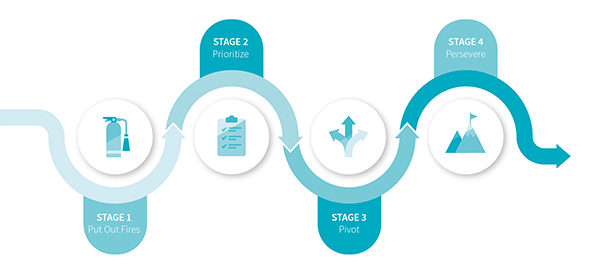
By Daniel Sztutwojner, chief customer officer and co-founder of Beekeeper
As the state of the world remains in flux due to the COVID-19 pandemic, the path forward is still unknown for many companies. The food industry has had a unique set of challenges throughout this unprecedented period with different impacts on companies.
While some companies have experienced a surge in business, others have had a shortfall depending on who their customers are and the demand for products. But overall, many companies have continued operating in some capacity.
While individual consumer demand for food and beverage products has increased by 29% at grocery stores, revenue has sharply declined from bulk-order clients. For instance, restaurant orders have plummeted 27% due to the sharp decline in consumers dining out, and schools closing impacted the dairy industry, who were dumping excess milk.
Despite these different experiences, food companies are regaining their footing and figuring out how to forge a path forward through uncharted territory into the next normal.
Companies who will fare best are those that:
- Have an agile and adaptable operational strategy
- Have an engaged, committed workforce
- Comply with suggested and mandated protocols to ensure workplace safety
- Demonstrate long-term resilience in the face of adversity
Since the food industry consists mainly of frontline workers, one of the most effective ways for companies to achieve these goals is to adopt a mobile internal communication strategy. This enables a company to move forward in unison, with everyone in the organization aligned with the company’s mission and strategies to stabilize operations during an evolving economic landscape.
Here are some ways companies can better position themselves for the next normal with a digital communication strategy.
Build a resilient workforce through inclusive communication
U.S. food manufacturing and processing employs nearly 1.7 million people, many of whom are essential workers who have continued showing up to work during COVID-19.
The key to keeping this workforce engaged and dedicated when anxiety is high is to strengthen the resolve of your workforce. A company can unify and align their entire workforce—from the front line to the c-suite—through a digital internal communication strategy.
Digitally connecting and enabling an entire organization builds a resilient workforce to survive and thrive during ambiguity. Several ways to do this include:
- Creating transparency for a safer workplace. There’s never been a more important time to be straightforward with your frontline workforce. Leveling the information playing field will make your organization stronger and safer. Transparency is key to keeping employees healthy by relaying constantly evolving protocols such as temperature checks, mask wearing, and workforce distancing.
- Offering routine moments of recognition. Working through a pandemic isn’t easy. While recognition should be a part of a leader’s everyday engagement strategy, it’s especially important now—letting employees know they are valued can boost morale and reassure them.
- Creating feedback channels. To phase into the next normal, it’s important that everyone in your company has a voice. Your frontline workers will have valuable and direct insight into operational issues. Get their feedback to accurately inform your next-steps strategy.
- Training managers in crisis communications. If you want an engaged, confident workforce, make sure your managers are solid leaders, able to stabilize insecurities and offer support to their teams. Provide leadership skills and training through internal digital channels.
Stabilize operations through agility
While disruption is never a good thing for business, companies can endure sudden events when they have an agile foundation that allows their operational system to bend without breaking.
Agility enables a company to anticipate operational bumps in the road and handle them with fewer repercussions and less, if any, downtime. It also allows a team to easily adjust production output and reskill workers to meet fluctuating consumer demands in products.
During COVID-19, food industry businesses are experiencing a variety of challenges, such as:
- How to procure resources when usual suppliers become unavailable
- Handling disruptions in logistics management
- Communicating updates to customers
- Disruptions to internal workflows and less product innovation
- Communicating with their entire workforce quickly
A business continuity plan can help companies prepare for the unexpected and mitigate risks. Companies should also plot out a digitally-supported recovery roadmap with four essential stages:
- Put out fires of immediate threats to lessen impacts to operations management
- Prioritize a business continuity plan that will aid in faster recovery
- Pivot strategies and procedures to achieve goals from a different approach
- Persevere at every level to create organizational resilience
Leaders can establish a more adaptable foundation through digital solutions that enable real-time communication, enterprise-wide collaboration for quick problem solving, and task automation that can withstand workflow disruptions.
Comply with evolving regulations and protocols
Right now, companies need to adapt internal policies and procedures to adhere to both suggested protocols, such as OSHA and CDC workplace safety procedures, and state and regional regulations. A digital communication solution enables a company to swiftly pivot to prioritize crisis communications throughout an organization for full compliance.
For example, the state of Virginia was the first to enact statewide workplace safety regulations during COVID-19. Part of the new law requires companies to inform all employees when a colleague who tests positive for the virus within 24 hours. A mobile-first digital solution allows companies to contact every worker at once, within the required timeframe, and confirm they have read the message.
A digital communications infrastructure and a recovery roadmap can counteract the unpredictable nature of a crisis and support food companies as they journey ahead into the next normal. A resilient organization can quickly right their ship and survive in the face of adversity.
 Daniel Sztutwojner is chief customer officer and co-founder of Beekeeper, the single point of contact for your frontline workforce. Beekeeper’s mobile platform brings communications and tools into one place to improve agility, productivity, and safety. Daniel is passionate about helping businesses operate more efficiently.
Daniel Sztutwojner is chief customer officer and co-founder of Beekeeper, the single point of contact for your frontline workforce. Beekeeper’s mobile platform brings communications and tools into one place to improve agility, productivity, and safety. Daniel is passionate about helping businesses operate more efficiently.








